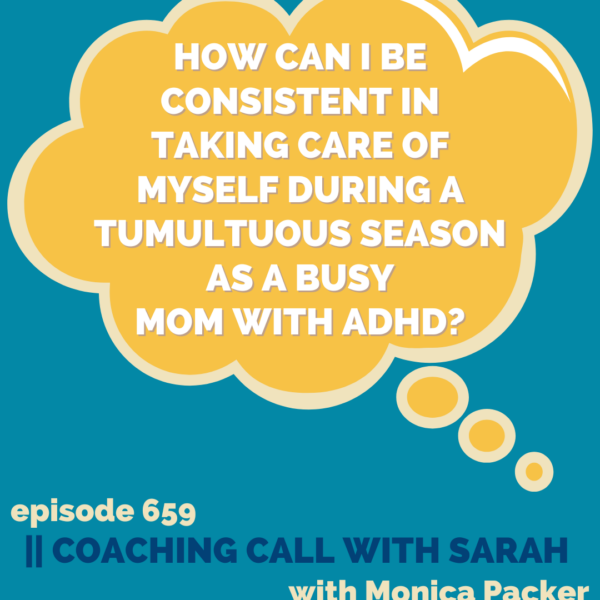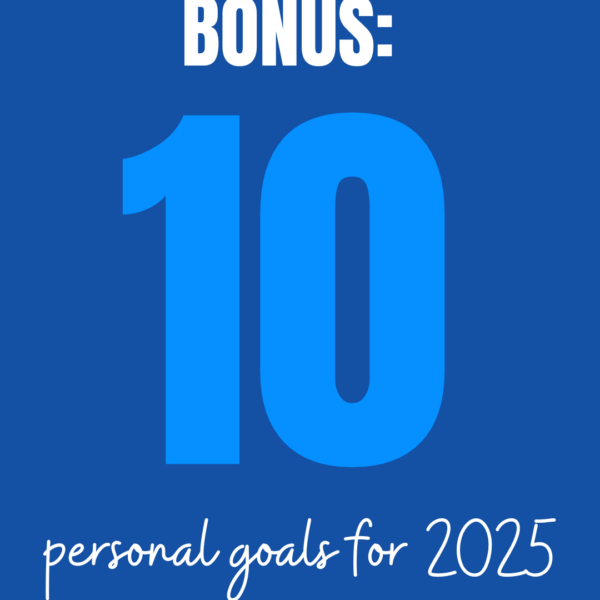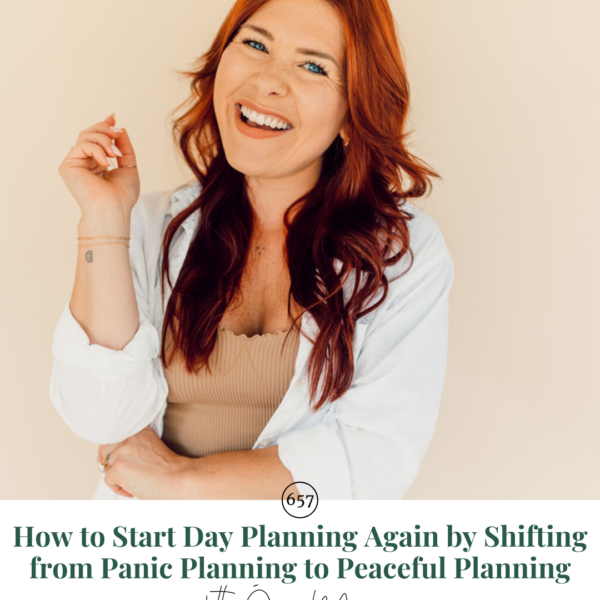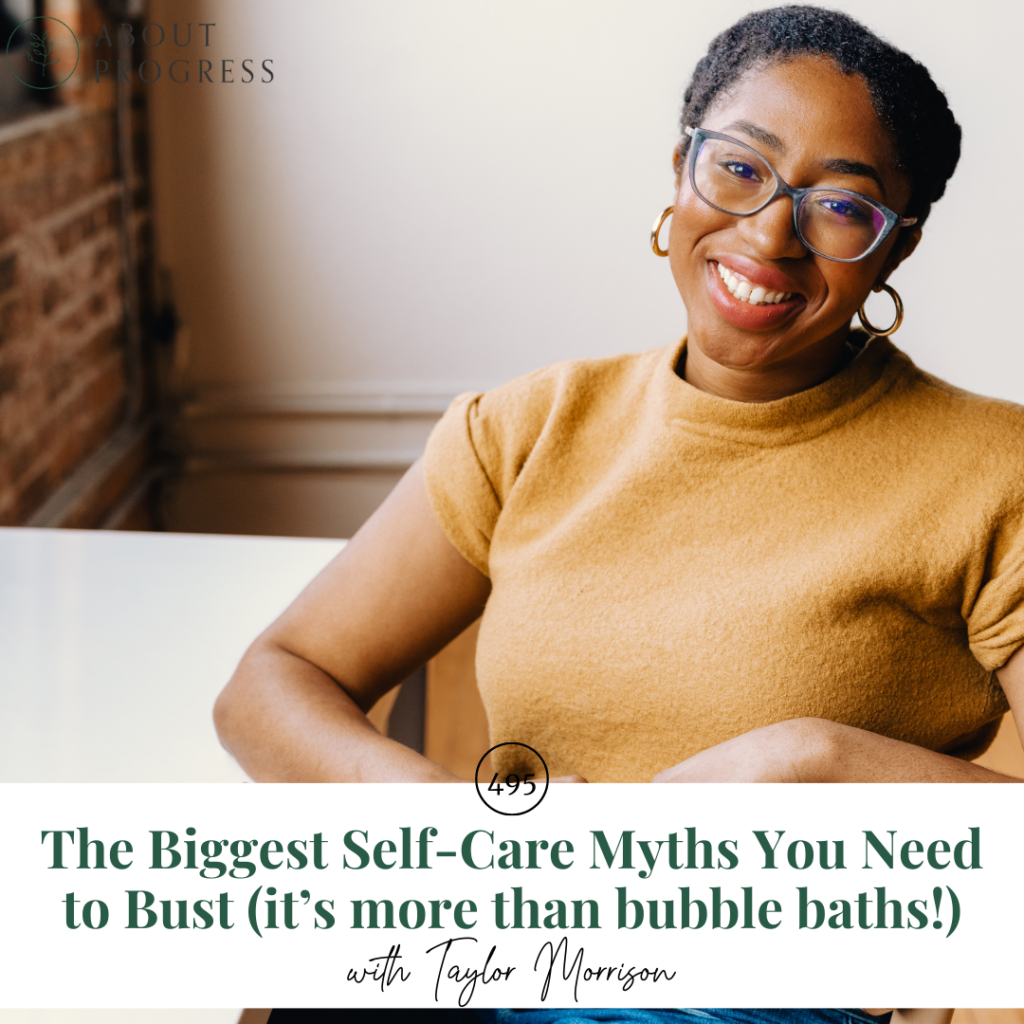
Does your day-to-day life have you feeling frustrated, overwhelmed, or irritable? Maybe you are squeezing in some self-care here and there, like a rare sweet treat, an occasional long shower, or other surface level practices. It’s possible that you are practicing self-care, and still not feeling cared for. Why does that happen? Because the things that we have been taught to look at for self-care, are really just barely scratching the surface.
Taylor Morrison, author of Inner Workout, sees self-care as a skill to be strengthened just like a physical muscle. She identifies, and debunks, the most common myths, to help us get to the root of effective self-care. You’ll also hear her explain the five dimensions of self-care, which gives us a holistic approach to the greatest act of care that we can give ourselves: understanding, and acting upon, what makes you feel like you.

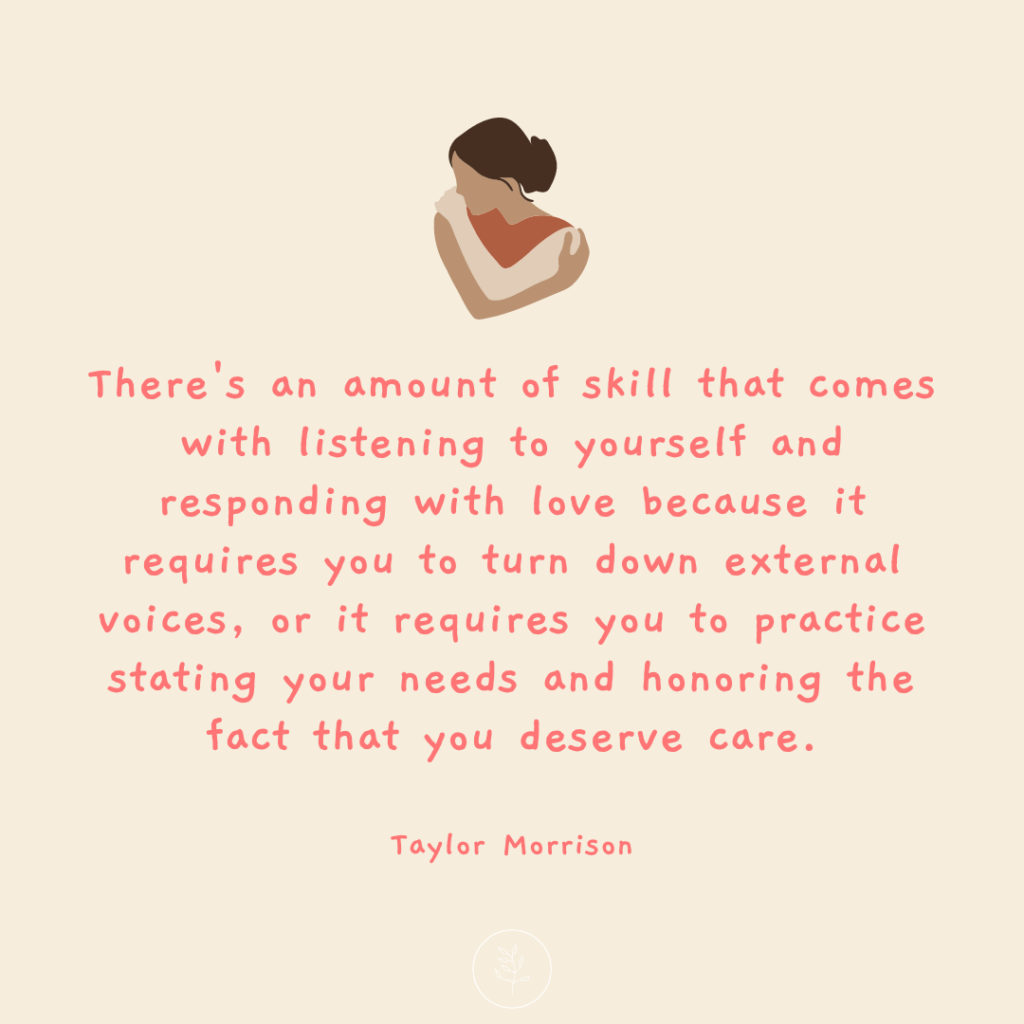
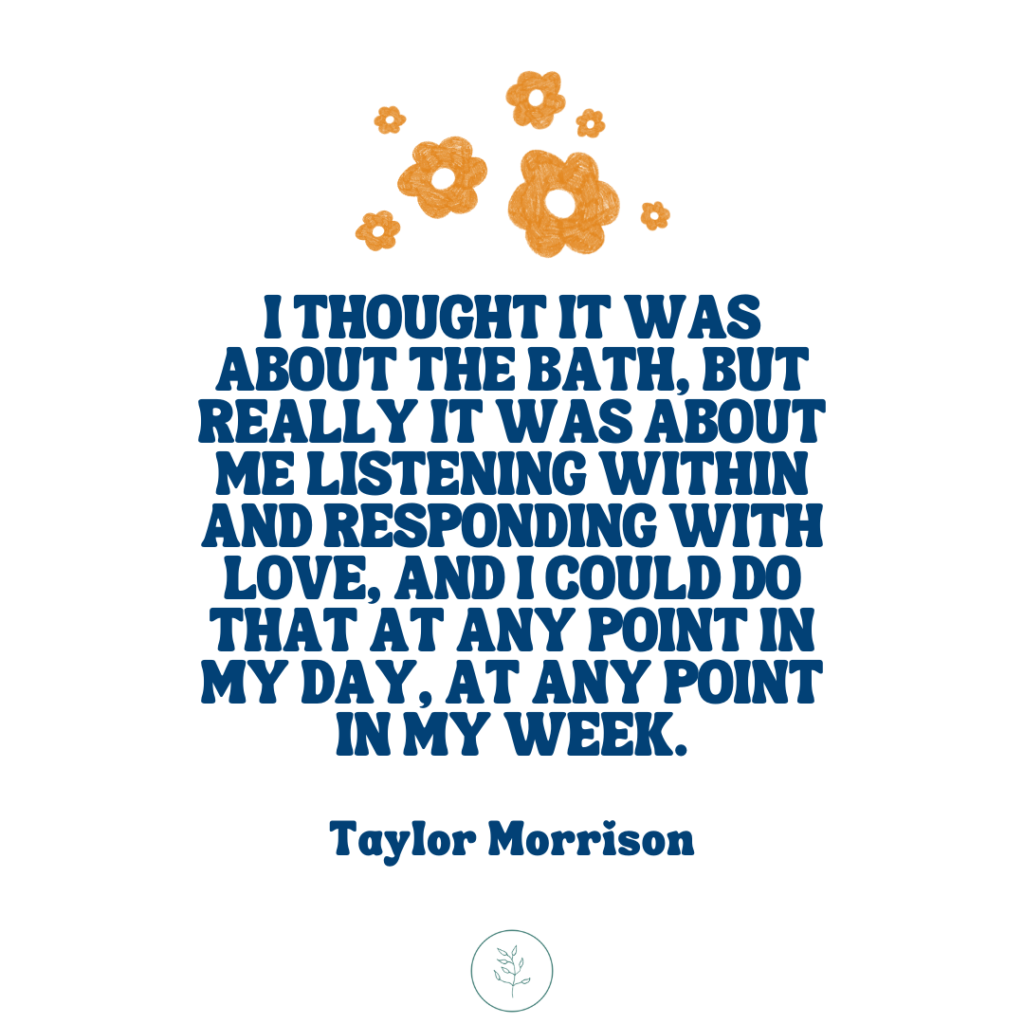
About a few other things…
Do you struggle to create habits that stick? It’s not your fault. The truth is simple: you’ve been trying to form habits using methods designed for perfect robots–not real women living real lives. It’s time to change that. If I could help you gain confidence in creating habits AND guide you to uncover the ONE supportive habit to deeply care for yourself, could you commit 21 days to learning this method? The Sticky Habit Method is a 21-day course that revolutionizes the habit-formation process. It’s real habits for real women.
Sign up for the Go Getter Newsletter to get Progress Pointers in your inbox every Tuesday.
Use code PROGRESS for 20% off a 90-day supply of Just Thrive Probiotic and Just Calm at https://justthrivehealth.com/discount/PROGRESS
You can listen the episode below, or on Apple Podcasts/iTunes, Spotify, Youtube, Overcast, Stitcher, Pocketcasts, or search for “About Progress” wherever you get your podcasts. If you like the show please share it, subscribe, and leave a review!!
SHOW NOTES
Taylor’s free assessment, website, book
Finding Me Academy
DSL Guide
Try me FREE Class and check out my NEW Habit Course
Leave a rating and review for the podcast!
Lend your voice and experience + be featured on the show HERE
Join Monica on Facebook and Instagram
Songs Credit: Pleasant Pictures Music Club
TRANSCRIPT
Monica: Taylor Morrison, welcome to About Progress.
Taylor: Thank you so much for having me.
Monica: Let’s start by talking about this loaded, but really common and often overused phrase, self-care and how you got into it first.
I would love to know that, and then we’ll talk more about how you see it differently than maybe we talk about it often in the zeitgeist right now. So how did this become a thing for you to care about self-care?
Taylor: It was really out of necessity, Monica, like I was so burned out and it was like this cycle of burnout where I would do a lot, and I know your listeners can relate to this, where I was doing all of the things.
I was volunteering, I was working, I was trying to have a social life and be connected to my loved ones, and I would get to a place where I feel overwhelmed and burned out, and then maybe I would quit some things or I’d be like, okay, this, this volunteer event is over, so I can pull back from this a little bit.
And then inevitably a few weeks later or a few months later, I would be back in the same place. Yeah. And I was just like, why? Why does this keep happening? And I was practicing quote unquote, self-care. Like I would take an afternoon off or I would maybe get a massage, but I wasn’t feeling cared for. There was like this real disconnect.
So it really came out of a place of need because I was. Yeah, I’m bad at self-care. I’m not naturally good at checking in with myself.
Monica: Yeah. You, you, you and I are similar in many ways, and this is one of them. I can get this like productivity hat on or it’s just almost part of like my blood cells almost like this drive to do, do, do, do, do when really, sometimes self-care can just be another like do on the list and it not, and it not be about really connecting. And that’s what I love so much about how you teach self-care. It’s not about putting band-aids on, although sometimes those band-aids are really awesome and helpful. It’s about the deeper stuff.
So let’s talk about the definition now of self-care. My favorite non definition is from Parks and Recreation, where two characters have a treat yourself day. I don’t know if you’ve seen that. Yes. That is what I think we used to think self-care as is just like a giant treat yourself or an occasional treat yourself, again can be part of it.
I want to hear what your definition of self-care is.
Taylor: Absolutely. And that Parks and Rec definition of self-care was absolutely what I thought self-care was too. I was like, yeah, I’m getting the massage. I’m like, splurging on a dinner. And it felt good in the moment, but then I was still overwhelmed and over time I started working with the definition that’s now like the foundation of the book and my work, which is that self-care is listening within and responding in the most loving way possible. And I think that’s especially useful for people like us because it shifts it away from another to-do list, another box to check into a conversation.
Monica: Mm-hmm. And that was pivotal for me. And it goes back to that disconnect you were feeling before because it wasn’t about like that deeper listening and like lovingly responding and that con conversation. It seemed like it was more of the bandaid level of self-care instead of the deeper. Let’s talk more about what we get wrong about self-care.
Cuz you have things wrong, I have things wrong. What are some myths that people should be aware of?
Taylor: Yeah. Well, I think going back to what we already shared, there’s a myth that self-care is, self-care is this Treat yourself, which there’s a lot wrapped up into that. I love that you brought this parks and rec metaphor because we, we see multiple things in that it’s about spending money.
If anyone listening has watched it, they’re like going to the stores, they’re buying completely new outfits. It’s like a very extravagant thing. Mm-hmm. That doesn’t happen frequently. It’s, it’s a treat. It’s this thing that you do every once in a while. You spend a lot of money on there. There’s, that’s too myth right there, that self-care has to cost a lot of money, which it doesn’t like now I know.
As someone who thinks about self-care a lot and works with other people on self-care. One of my clients recently, we realized that one of the most caring things that she could do for herself was give herself permission to read fiction instead of non-fiction. That costs $0, you know? Mm-hmm. That’s just all about listening to herself and what she actually need and what would actually feel supportive for her.
Hmm. So that’s a myth right there, that self-care has to cost a lot of money. And then another thing going back to that Parks and Rec reference is this myth that it’s like treat yourself as one day a year in Parks and Rec. And so it’s this thing that you like. Have to earn. Mm-hmm. You can’t experience it every day.
And I think it’s actually the opposite. Okay. Feeling cared for is something that we all deserve and it’s something we can access on a daily basis. We don’t have to wait for a special occasion.
Monica: There’s two more you talk about in your book that I wanna make sure we hit on as well, and one is the time element.
Can you speak to that as well? That it’s supposed to take a lot of time.
Taylor: Yeah. I know for me, when I started doing more things around wellness and wellbeing, then I started to have, it’s like the doer in me was like, okay, well if I’m gonna meditate, then I should be meditating the right way, which is 30 minutes or 60 minutes.
Or if I’m gonna move my body, then I need to be doing the most. Time intensive way of moving my body. And what I find it actually makes me really sad when I see that showing up in myself and with other people, is that that often gets in the way of us practicing care. Cuz it could be like, I have two minutes here.
But I’m supposed to be doing this thing for 20, 40 an hour, so I’m just not gonna use the time that I have because I can’t do it the quote unquote right way. So when we think that self-care has a, has to take a lot of time, we actually miss, and I can speak from the eye here cuz I do this, I miss opportunities to care for myself using the little pockets of time that are available to me.
Monica: That idea right there alone, I think revolutionizes self-care completely and including coupled with your others that you’ve taught about too, about it being more of a regular thing, not just like a once a year or even once a month or once a week sort of thing. And the second myth I wanna talk about that I learned from you is we often just can make self-care another task, another thing on our to-do list.
And instead you talk about it as a skill. What do you mean by that?
Taylor: Yeah, I, again, speaking from the I, I had to learn how to care for myself. I had to learn how to listen to myself and lovingly respond to what I’m hearing with the resources available to me, and that that takes work. Like there’s kind of a reason that my company and my book is called Inner Workout because we can understand the concept of like, Building endurance or stamina when we’re moving our bodies.
But there’s also an an amount of skill that comes with listening to yourself and responding with love because it requires you to sometimes turn down external voices, or it requires you to practice stating your needs and honoring the fact that you deserve care. It’s all skill building. Like sometimes I’ll, I’ll be having these internal battles with myself almost where I’m like, okay, I can tell that I need this, but that means saying no to someone, or that means doing something that someone in my life won’t understand and it takes skill to like work up to doing that at a higher and higher level.
Got it.
Monica: That actually gives me hope. I think a lot of people might hear that and just think, well, that’s a skill I don’t have time to learn, and let’s go back to what you talked about with time, because it’s little bits and pieces. It’s moments of of, of just taking a tiny bit of time to listen in or a moment to prove yourself wrong, where you’re like, this minute of meditation is going to count, instead of me thinking it has to be 20 minutes.
And that’s how you develop that skill of listening within and responding in the most loving way possible. Your definition of self-care. Before we move into some practical ways they can learn to implement this.
I wanna go back to your backstory when you were pretty burnt out. How did you begin to make this a skill set rather than other tasks? Like how, what did that look like? This transition to your definition of self-care instead of the old way you used to define it and then not practice it very well?
Taylor: Yeah. I think the first piece is to be really clear that like this took time. It wasn’t like, okay, I’m not burned out anymore, or Oh, I don’t get to a place where I am overwhelmed. It took time and I talk about in the book how like, Now, I’m telling people all the time that self-care is more than bubble baths, but for me, it started with this weekly practice of taking a bath on Sunday evenings, putting aside my phone, putting aside my laptop, and that was really me building the skills, self-care, understanding that if I wanted to show up monday through Saturday, the way that I wanted to show up, I had to take time for myself on Sunday evening just to be with myself. Those were the times when I was journaling or reading a book that I enjoyed and really learning like how to ask myself what I need and to give that self to me and or, or give that to myself and then over time, Just doing that on Sundays wasn’t enough like that one check-in, what do I need on Sunday night wasn’t enough, and I wanted to be able to feel like that throughout the week, and I realized that I thought it was about the bath, but really it was about me listening within and responding with love, and I could do that at any point in my day, at any point in my week.
Monica: Can you give me an example of what that might look like? Just like even recently where you took a second, you looked in and then you realized this is what I need right now in this moment.
Taylor: Yeah, absolutely. So I do this a lot in mornings. I know that moving my body in the morning just completely restructures my day and it’s a really grounding point for me.
So that’s in most cases non-negotiable. But or, and I’m working on saying, and instead of but, and it is. I give myself a lot of freedom to check in and say, okay, what does movement look like today? Mm-hmm. Today, I just walked on my treadmill. Yesterday I was doing a boxing work out. The day before that I was doing a hiit workout.
Tomorrow I might do Pilates or yoga or just stretch for 10 minutes. So I know generally this is something that is caring and supportive for me, but I check in every day to see. Okay. What does this look like? Sometimes it’s just taking a long walk. I live by the lake in Chicago. Sometimes it’s just going to the lake and doing a long walk by the lake.
In my work days it is, and there’s always this mix between like flexibility and structure. Mm-hmm. So I love in my days, in my months, knowing what my big three priorities are and I check in with myself to see, okay, which three. Which of my three priorities for the day, for the month, for the week, do I have the most like energy and excitement to work on right now?
And I can plug into that. So I’m still working towards where I wanna go, but I’m checking in with myself. And often a lot of that too, what I was working on even yesterday is like making sure I’m taking breaks throughout the day and honoring when I can take five minutes and go get a cup of water.
And look at Instagram for a little bit or send a voice note to a friend. So those are a few examples of how that actually shows up in my work life and my personal life.
Monica: That mix and balance of structure and flexibility, I think is what’s so beautiful about what the skillset can turn into over time, just more of an intuitive way of taking care of yourself.
So it, it kind of helps to start with the structure piece. I think as you then learn the flexibility part, which I think is a harder part of that skillset. And another part is how to make it not just be about the band-aids. I want to dig into your five dimensions of self care. That women could be considering when they’re kind of thinking for themselves, well, what does self-care look like for me?
Including maybe the bandaid ones. Again, I don’t mean to say it as a like to disparage that kind of stuff, but that’s what I love about these five dimensions is how we can see it as part of the ways we care for ourselves. So tell us a little bit more about the five dimensions of self-care that women can consider for themselves.
Taylor: Yeah, I loved talking about these because this was another like pivot point for me in my understanding of self-care and what wellbeing. So the five dimensions of wellbeing are inspired by this yogic concept of the koshas, and I’ve kind of expanded on them and added all of these sub-dimensions and, and the biggest piece before we get into them is that, It’s, if nothing else, it’s a reminder that you are this whole multi-dimensional, integrated being.
And what can happen sometimes when we’re practicing self-care is that we can focus on one aspect on our of ourselves and then not feel cared for because it’s actually a different part of us that needs care. Mm-hmm. So the five dimensions, there’s the physical dimension, which is looking at your the conversation you’re having with your body.
Okay. How are you hearing able to hear what your body is saying to you? And then what are you saying to your body? Because it’s a two-way conversation, and I don’t know about you, but I’m not always saying the kindest things to my body. Yeah. Then there is the energetic dimension, which looks at how your breath is supporting or detracting from your wellbeing, and then also the way that energy is working.
In your daily life? The quick example I always give is we can, we’ve all had experiences where we leave a conversation and we’re feeling so energized afterwards, or the opposite where we leave a conversation and we’re feeling really drained. Mm-hmm. And that exchange of energy is happening throughout our days, throughout our lives.
And so the energetic dimension and the energetic zone, sub dimension is looking at that. Then we have the mental and emotional dimension. That’s one dimension that looks at how you are using your brain. Are you like challenging yourself in a way that feels good? It looks at what is flowing out of your brain in the form of thoughts, feelings, and emotions.
And then that’s all supported by sleep. Because yes, sleep affects how we’re feeling physically, and it also affects how we feel. Emotionally, how we’re able to process emotions. Then we have the wisdom dimension, which is about accessing your power in the present moment, being connected to your inner knowing and then taking aligned action.
It’s one thing to know something and to have that gut feeling or that heart feeling, wherever you feel it. It’s another to do something about it. Hmm. And then finally, there’s the bliss dimension, which is all about connection. Connection to the truest, fullest expression of yourself, connection to community, and then connection to something bigger than you.
Monica: Love them. And women, women. Hear these and they’re kind of pondering them. You kind of give us some examples of how that can break out into forms of self-care. You know, breathing, sleeping, moving. I imagine meditating is part of wisdom, connection. It’s, you know, at least to self and to others.
So I’m, I, I’m sure there’s some self-care practices that can help with that. Let’s dig into one that you think. They might not think of readily and some examples of self-care practices that go with that de dimension in particular.
Taylor: Yeah. Bliss is something I, that dimension I think is often surprising to people.
So we can go into that one. I’d love that. First of all, like even before I started doing this work, I always thought of bliss as like, oh, I have a massage. I’m so blissed out, like disconnected. Hmm. When it really is about deep connection. I also find that when I am feeling particularly burned out, and even the way I talk about burnout is the state of deep disconnection. I’m disconnected from myself, I’m disconnected from my community. I’m disconnected from something bigger than me or feeling like I have a higher purpose.
So the practices that you could do in the bliss dimension, something that I’ve been working on is like, Understanding. This is gonna sound so simplistic, but being really curious about what I like and what I want. Like what I’ve realized is that so many of,even something as simple as like how I decorate my home.
Mm-hmm. For a while I was so afraid to have like a perspective in my home that like everything was so neutral because I was like, well, I. I don’t know what colors I like, and if I do this loud color with this thing, are people gonna judge me? And so starting to understand, oh no, I, I actually like color.
And now our room is like this dark teal kind of moody color. But it was a process of like noticing what I liked in interior design or noticing things that I genuinely wanted versus like what a trend was. Gotcha. So I recommend to people just like, If you feel a spark of, Ooh, I like that, or, Ooh, that’s interesting to me.
Like, take note of that. And then over time you’ll start to act on it and integrate pieces of those things that you like into your life.
Monica: Can you just gimme one example for yourself then of like what that looks like in a more regular self-care kind of practice?
Taylor: Yeah. I, for me, I. And that’s what’s funny is because. To me it does feel very caring. Mm-hmm. To start to notice, ooh, I’m drawn to this thing. Like right now I’m on a shop Goodwill Kick. I don’t know if you know, but Goodwill has like an online site that’s kind of like eBay and I did not know this. It’s amazing.
Wow. And I just got like this amazing vintage leather coat and I. I like felt drawn to it, and I’m starting to realize, okay, what do I like about it? I like that the waist is defined. I like the silhouette, and so I did end up buying myself the coat and got an amazing deal on it, but it’s also this practice of understanding, okay, these are the things that I like.
These are the things that I feel good in. These are the things that make me feel like me. Mm-hmm. I would even say like the, I’ve seen you on Instagram talking about your style and things. To me, that’s an act of care to understand what makes you feel like you. Whether it’s clothing or whether it is how you’re decorating your home mm-hmm.
Or how, what you’re, what interest you’re exploring. It starts with, for me at least, it starts with kind of like a gathering process. Of understanding and then it’s starting to externalize it.
Monica: Mm-hmm. And that’s where the, the taking action piece comes into play that you also talked about with wisdom. It’s doing something, which is a big phrase we use in this community.
It’s doing something and, and it’s starting with the openness, that curiosity, like what looks and feels like me? What, what small things can I do to, to reach this part of myself that isn’t getting met right now? I think back to years ago. I, I recently was rereading the book Burnout by the Nagoski sisters, and they talk about how exercise is fundamental to completing the stress response cycle.
And I was thinking back to seven years ago when I was probably the most burn out in my life and I was realizing I was exercising a ton. So I’m like, what was wrong there? And to me it’s, I was missing. These other dimensions that you talked about, starting with bliss, the connection piece. Not even knowing what I liked and wanted.
Even my exercise was about shoulds, not about that deeper connection piece. And I would say one example that I can share and add to this is listening to music that I like around my kids. Maybe even while we’re doing things around the house or chores that we have to do. Like I know if I am feeling a little bit.
Tired or worn down, or even sad that I need certain types of music, whether it’s Harry Styles or Brandy Carlisle, to get myself back in a place where it is, I feel more like myself again. I can connect back to myself and I can connect back to my relationships and my responsibilities. So hopefully it’s okay that I, my added what, you know, you’ve taught me and how that’s applied to my life.
But I just think it’s so important. I, if I hadn’t. Recognized those other dimensions, I think I would be in the same spot.
Taylor: Yeah, I love that you added that too, because it’s, I think before I started conceptualizing self-care this way, I would’ve been like, Monica, you choosing music is not self-care, but that simple choice like.
You, you just said how it brings you back to yourself, how it connects to you, how you’re doing something that you want. And I just hope as people are listening, there’s so many things that you could consider care and you could celebrate as an act of care, but we just kind of discount them as no self-care has to be this big time intensive endeavor.
Monica: So let’s help them act on this a little bit more. Let’s give them some ways they can do something to start better prioritizing. They’ll set their self-care and build what you talk about as a self-care support system. How it’s not just about one thing, it’s a whole system, like almost a whole network of ways that you listen and respond to your needs and wants.
What are some small ways they can do something to better prioritize self-care in their lives right now?
Taylor: First thing is find a time where you can listen to yourself. So I, for me, it’s easiest if I can pair it with a certain task. I mean, this is like habit stacking, pair it with a certain task or a certain point in my day.
So for me, when I’m walking my dog in the morning, that’s a time for me to check in with myself. For you, it could be, Like the first five minutes in the line for pickup at your kids are for you. And then after that you can put on a podcast or put on music. Brilliant. So yeah, finding time to listen to yourself is big because that’s how you start to respond with love if you don’t have anything to respond to.
Mm-hmm. It’s gonna be hard to practice self-care in the way that I’m talking about. So that’s step one, is find a place to listen. I will offer. We have the take care assessment, which is a free assessment, measures your wellbeing across the five dimensions and gives you three practices as a starting point.
Brilliant. So that’s like an an easy thing that you can do where you, if you’re like, these five dimensions are interesting, but I don’t know exactly how they show up in my life. That’s a good starting point for people. The other thing that I would say is try and I think even once a day, To do something that, like, to go through that whole loop of what do I need right now?
What would make me feel cared for? And to give it to yourself in some small way. Mm-hmm. I’d almost say bonus points if it, it can be short and sweet. Okay. So earlier you were talking about like the one minute meditation. That’s actually one of my favorite meditation practices. My teacher, Dr. Iza, Yvonne.
Taught me it in the training that I went through. Mm-hmm. And it’s really, really simple. First 20 seconds, you are fixing your posture wherever you are. Okay. I, my, my back is going up as we’re speaking this. Yes, exactly. There’s always like some shift we can make. Second 20 seconds, we are focusing on our breath.
Third, 20 seconds, we’re checking in with our body, doing a quick body scan. That’s a minute and I guarantee you will either feel better or more grounded or notice something about yourself in that minute. So if you can do little micro practices like that, what do I need right now? Hmm. Ooh. It would feel nice to stretch real quick and then celebrate the fact I just cared for myself.
It’s almost like a recalibration of this is care. That is care. Look at all of the ways that I am already caring for myself. That’s how you build the momentum to make bigger and bigger shifts in your life.
Great. Let’s discuss your book
Monica: and where they should go to find it and to learn more from you.
Taylor: Yes. The book is called Inner Workouts, strengthening Self-Care Practices for Healing Body, soul, and Mind. I’ve jokingly said it’s like my dissertation on self-care, but it’s a lot more readable than a dissertation. And it really expands on the five dimensions of wellbeing. So you’ll be invited to take the assessment, but the assessment is free.
So if you’re like, I’m not a reader. Just take the assessment for free. But it builds on, that’s too, just so we know. We’ll, we’ll make sure to link that to that. And it expands on the five dimensions and the sub-dimensions. And the first half of the book is, or not even half the first, maybe third quarter, I don’t know exactly is.
A more robust version of the conversation that you and I had today, like really laying the groundwork for what self-care is the way that I’m talking about it through inner workout. And then that second part of the book is, okay, where am I? Which dimension I. Needs the most care. Mm-hmm. There’s an explanation of the dimension.
There’s personal essays about my own experience with the dimensions, and then there’s practices that you can try. There’s a ton of journaling prompts too, and there’s also inspiration from people, whether it’s authors or actresses or researchers who I think. Really have a lot to teach us with how they embody that dimension or sub dimension.
So my goal was to make it really practical, really accessible, and also a resource that you could turn to a page and get something out of it.
Monica: Well, I can say that you succeeded. I think it was brilliant and is a resource. The thing I can refer back to, and that’s also, like you said, it’s easy to read.
If they want to follow you online, where should they go?
Taylor: Yes. So I like to say that I’m kind of on Instagram as is inner workout. I’m at Taylor Elise Morrison Inner Workout is at Inner Workout, but if you’re looking for like more ongoing support and thoughts about self-care, I really recommend signing up for our newsletter, which is called Self-Care Sundays.
That goes out every Sunday, as you might guess. Yeah. Awesome.
Monica: Taylor, this has been lovely. And I really appreciate all that you’ve learned and how you teach it and that we got to benefit from that today.
Taylor: Thank you for having me. And I love hearing like you talk about how this is showing up in your own life. That’s the most exciting part of getting to do this work is to see how other people are iterating on it and using it in their own lives. Cuz that’s the point.
Monica: Well, I can promise you you’re gonna get a lot of that thanks to this book.
Thank you again.
You talked
about being pretty burned out and then I never know how to say that on a hindsight.
Like, is it burnt out or burn? Burned out?
Taylor: Do you know what I’m, I’m gonna cut that out. Yeah, they both work. I’m like I,
Monica: how to say it.
